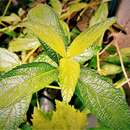pt-BR
nomes no trilho de navegação


Lippia abyssinica, or koseret (Amharic: ኮሰረት, romanized: koserēt), is a species of flowering plant in the verbena family, Verbenaceae. It is endemic to Ethiopia but cultivated throughout tropical African countries.[2][3][4] The specific epithet abyssinica derives from Latin and means 'of or from Ethiopia (Abyssinia)'.[5]
The plant grows as a 3m tall shrubby herb[6] at 1600–2000 m altitude in Ethiopia.[7] It has hairy leaves and small flowers that are purple or pink.[8]
Other common names include kosearut,[9] lemon herb,[10] butter clarifying herb,[11] Gambey tea bush,[12] and Gambia(n) tea bush,[2][3][13] although the latter can also apply to Lippia multiflora.[14] Besides the word koseret, in Amharic it is also called kesse[8] or kessie.[7] In Gurage it can be called koseret (Amharic: ኮሰሬት, romanized: koserēti), kesenet (Amharic: ክስንት, romanized: kisiniti),[15] or quereret.[8] Said in Tigrinya it is kusay.[8] Kasey,[8] kusaye,[7] or kusaayee[4] are the terms in the Oromo language. In French it is called verveine d’Afrique (literally 'African verbena'),[3][14] Brégué Balenté, or Mousso et mâle.[16] German speakers call it Gambia-Teestrauch (Gambia tea shrub).[14] In Sierra Leone it is named a-kimbo and in the Congo it is called ngadi or dutmutzuri.[12]
Koseret, specifically the subspecies L. a. var. koseret, is dried and used as an herb in Ethiopian cuisine. The smell is camphorous and minty.[16] Some describe its flavor as being similar to basil,[17] but it is not closely related to that herb (they are merely in the same order, Lamiales). Koseret is closely related to the herb Mexican oregano (not to be confused with oregano), sharing the same genus Lippia. It is commonly used in making the spiced oils niter kibbeh[17][18] and ye'qimem zeyet[9] and the spice mix afrinj. Koseret along with the other herbs and spices preserve the butter and oil, preventing spoilage for up to 15 years.[18] In these preparations koseret then flavors many common dishes, such as kitfo.[19] In Democratic Republic of the Congo and Republic of the Congo it is eaten as a potherb.[20][2][3] In west Africa, notably The Gambia, it is brewed into a tisane as a substitute for tea.[2][3][13]
The plant has also been used as traditional medicine for cough,[12][16][3] fever,[7][16][3] constipation,[12] and cutaneous conditions[12][6] such as burns.[4] It also is used as an insecticide and antimicrobial treatment[12] and shows some promising antibacterial properties.[6] Koseret has some antioxidant activity as well.[18]
Lippia abyssinica, or koseret (Amharic: ኮሰረት, romanized: koserēt), is a species of flowering plant in the verbena family, Verbenaceae. It is endemic to Ethiopia but cultivated throughout tropical African countries. The specific epithet abyssinica derives from Latin and means 'of or from Ethiopia (Abyssinia)'.
 Herbarium specimen
Herbarium specimenThe plant grows as a 3m tall shrubby herb at 1600–2000 m altitude in Ethiopia. It has hairy leaves and small flowers that are purple or pink.
Other common names include kosearut, lemon herb, butter clarifying herb, Gambey tea bush, and Gambia(n) tea bush, although the latter can also apply to Lippia multiflora. Besides the word koseret, in Amharic it is also called kesse or kessie. In Gurage it can be called koseret (Amharic: ኮሰሬት, romanized: koserēti), kesenet (Amharic: ክስንት, romanized: kisiniti), or quereret. Said in Tigrinya it is kusay. Kasey, kusaye, or kusaayee are the terms in the Oromo language. In French it is called verveine d’Afrique (literally 'African verbena'), Brégué Balenté, or Mousso et mâle. German speakers call it Gambia-Teestrauch (Gambia tea shrub). In Sierra Leone it is named a-kimbo and in the Congo it is called ngadi or dutmutzuri.
Lippia abyssinica là một loài thực vật có hoa trong họ Cỏ roi ngựa. Loài này được (Otto & A.Dietr.) Cufod. mô tả khoa học đầu tiên năm 1969.[1]
Lippia abyssinica là một loài thực vật có hoa trong họ Cỏ roi ngựa. Loài này được (Otto & A.Dietr.) Cufod. mô tả khoa học đầu tiên năm 1969.
코서러트(암하라어: ኮሰረት, 학명: Lippia abyssinica 리피아 아비시니카[*])는 마편초과의 여러해살이풀이다.
에티오피아 등 아프리카의 뿔 지역부터 동아프리카를 거쳐 앙골라에 이르는 지역에까지 분포한다.[2]